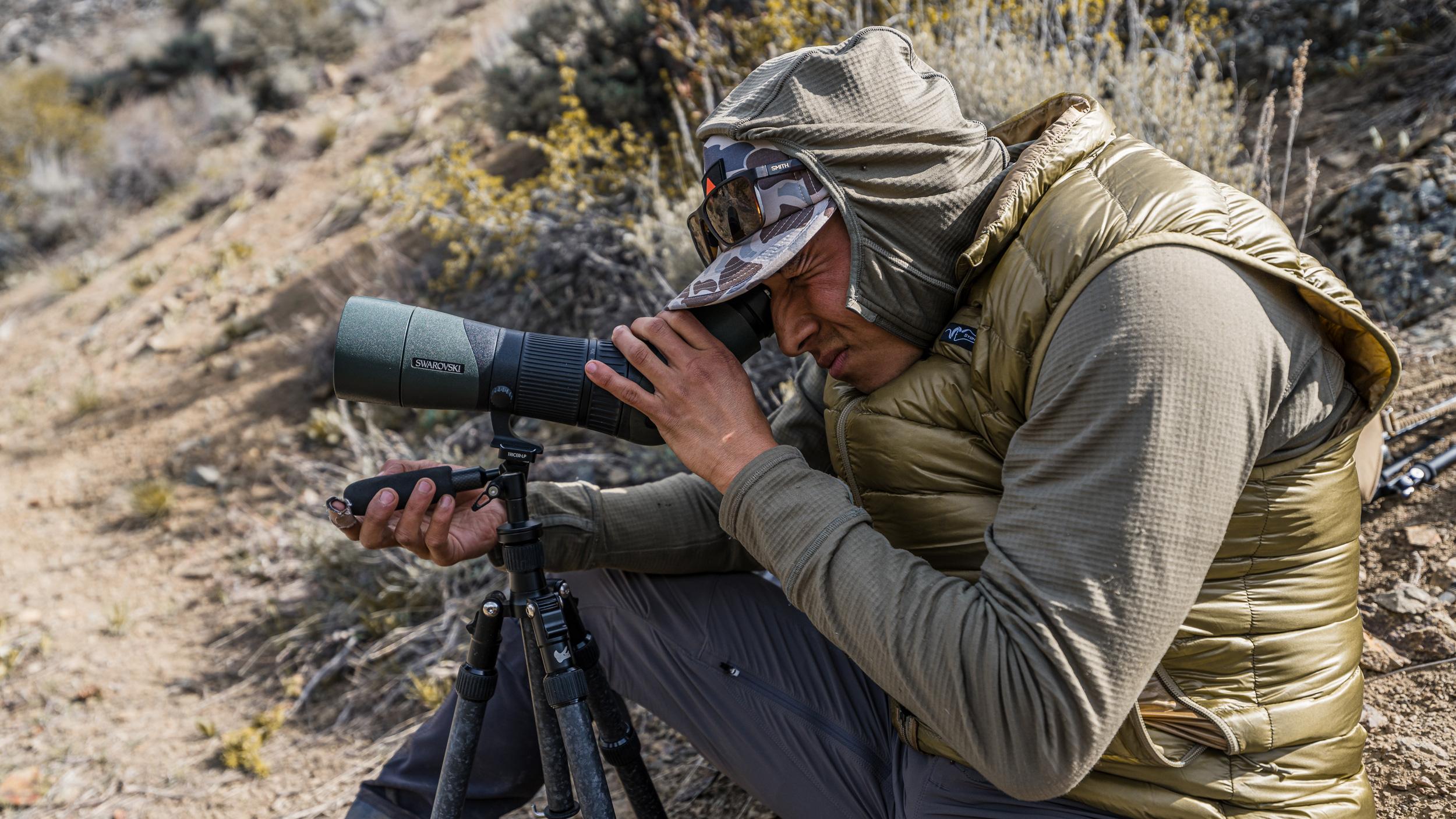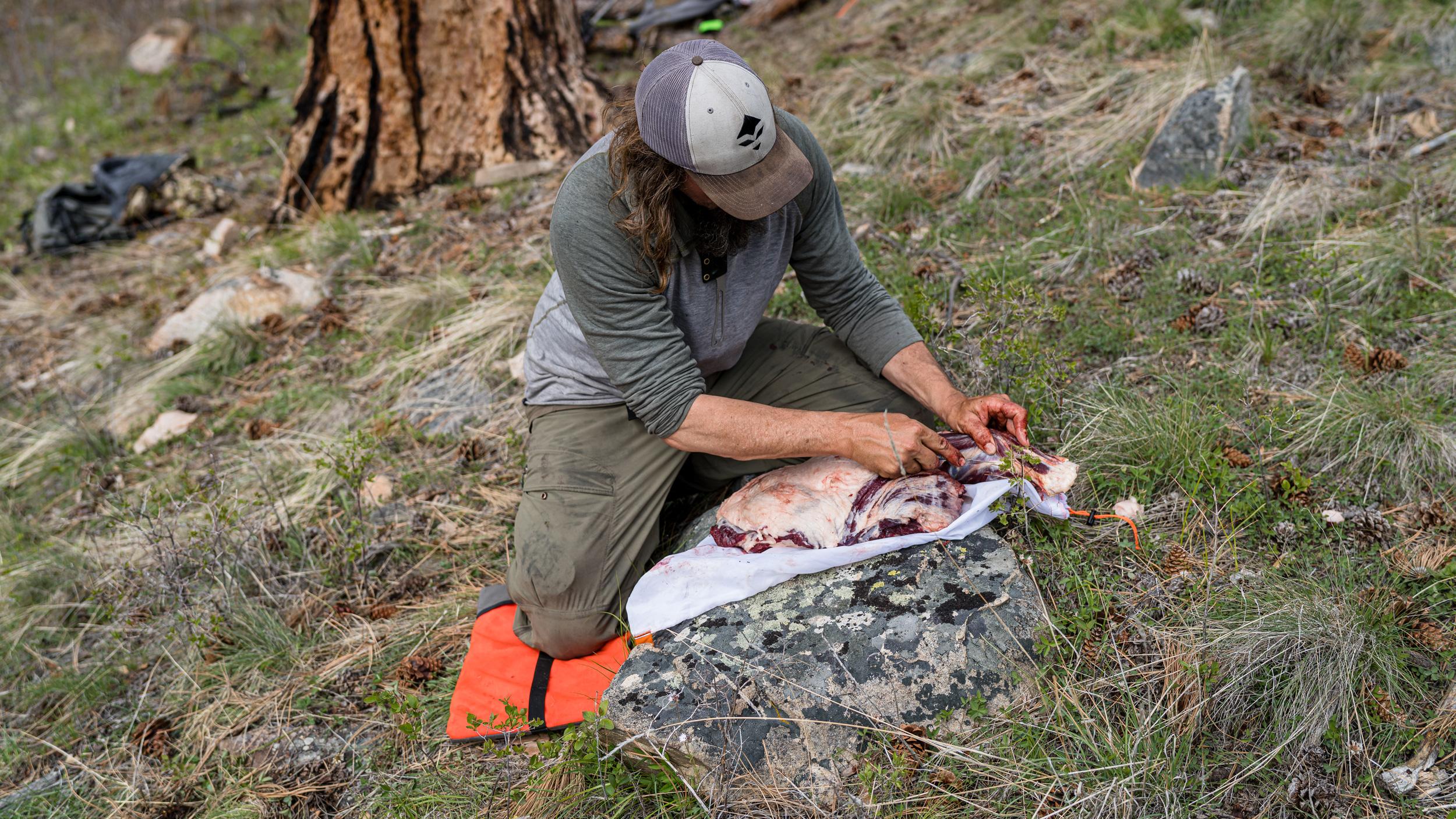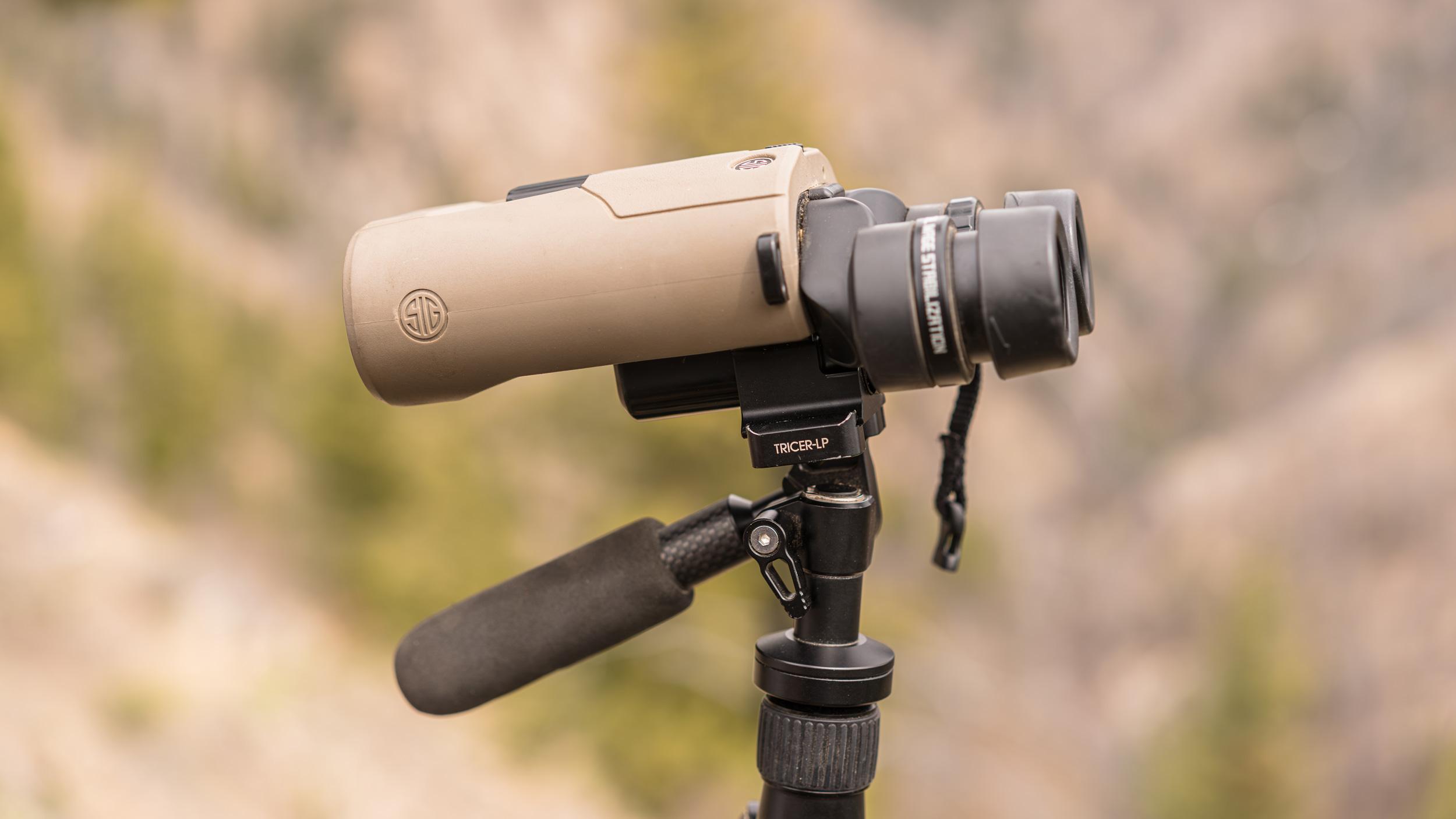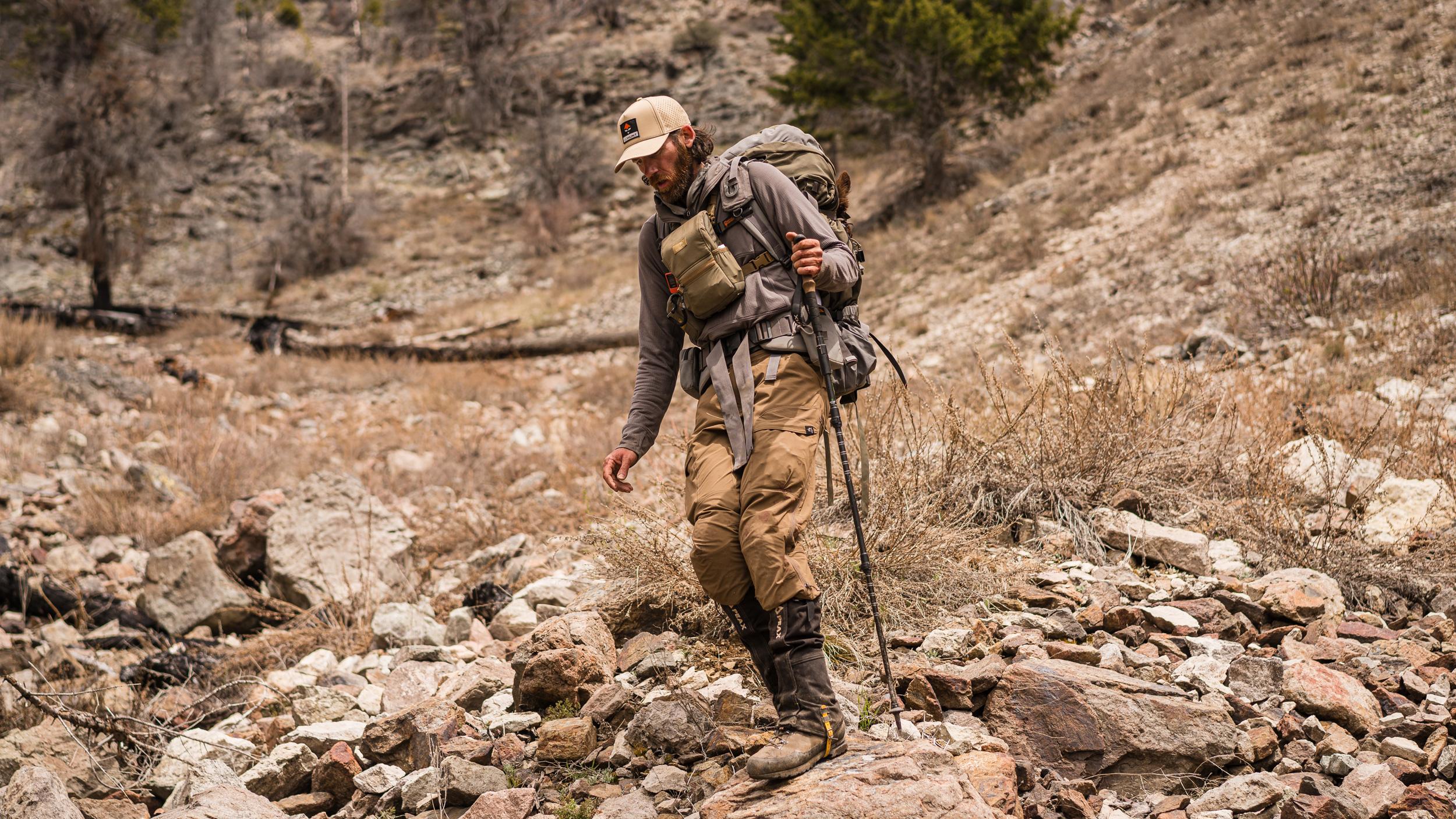




Brady Miller glassing with SIG SAUER ZULU6 HDX 16 power image stabilization binoculars

Omar Lopez glassing with Swarovski 65mm ATX spotting scope

The StHealthy Hunter glassing pad is multi-purpose. It is obviously great for glassing but can also be used for cutting meat, relaxing back at camp, etc.

Tricer BC tripod and Tricer LP pan head for glassing spring bears

Brady Miller packing out black bear using Peax trekking poles
As winter finally relinquishes its hold on the western backcountry, a transformation unfolds. This is the time of year when the snow starts to retreat up the mountain and the green wave starts to creep up the slopes. For hunters, this signals the anticipated beginning of spring bear hunting seasons across the western states.
During this time, my focus begins to shift to evaluating snow cover, depth and melting progress. These are critical aspects when it comes to pursuing bears in western states that have significant snowpack.
My Treeline Academy Google Earth Pro Map Toolkits and CalTopo Sentential Satellite Imagery, as well as my, GOHUNT Maps Terrain Analysis Tool are getting a serious workout. You can find out more about my toolkits at: www.treelineacademy.net
While my addiction to chasing elk in the backcountry remains as strong as ever, over the past decade, my interest in spring bear hunting has surged. It’s now a very close second.
Spring bear hunting offers a backcountry challenge that can be as demanding as you make it. This is part of its allure. As the saying goes, “You get out what you put in.” This could not be truer when it comes to pursuing spring bruins. It's a great time to shake off winter, test your fitness and dial in your gear selections.
E-scouting and hunt planning are always huge priorities. In high mountain western snowpack states like Montana, Idaho and Wyoming, snow level analysis is a game changing preparation method. The analysis process is dynamic and can be difficult to pin down.
Success or failure in the spring bear spot-and-stalk realm hinges on your ability to spot bears, often at great distances and across varied terrain. Pre-hunt e-scouting is essential. If you have done your pre-hunt e-scouting work, you have carefully dissected the landscape, evaluated the terrain and slope, tested glassing views and figured out the perfect vantage spots.
The most successful bear hunters I know have designed their glassing systems so they can spend hours upon hours breaking down the country looking for those often slow moving early spring bears.
A well designed glassing system will keep you comfortable behind the glass for longer periods. The more time you can spend on a glassing perch, the better your odds of locating bears. Over the past decade, I have continued to hone and refine my spring bear glassing setup. It is crucial to success and I’m always evaluating and testing new options.
Locating bears is job one, and your optics system can be the defining factor between success and failure. In this article, I’m going to break down the key components of an effective spring bear glassing system, highlighting the essential tools that backcountry spring bear hunters should strongly consider incorporating into their gear lineup.
“You can’t chase what you can’t find”
Western hunters often make huge investments in binoculars, prioritizing glass and image quality above all else. I used to share that same perspective until a few years ago. While image quality remains important, I've come to realize the significant advantage of combining glass quality with image stability.
Initially, I was very skeptical of image-stabilizing binoculars, dismissing them as gimmicky devices unfit for any kind of serious backcountry hunter. The thought of using what appeared to be space age toy-like binoculars seemed ludicrous. However, I admit, I was wrong!
My introduction to these binoculars occurred after a spring bear hunt mishap as I was crawling across a wet log over a fast moving creek. My Vortex Razor HD 12x50 binoculars, unsecured in my harness, tumbled into the spring melt water. A huge rookie mistake for sure. This situation forced me to try the Sig Sauer ZULU6 HDX 10X binoculars, and my perspective on glassing underwent a profound transformation. These image-stabilizing binoculars were game changers in almost every aspect and are perfect for hunting spring black bears.
I could write an entire article on these binoculars and their benefits, and I probably will very soon!
The full lineup of ZULU6 models sets a new standard by minimizing and virtually eliminating image shake and vibration. Holding traditional binoculars steady is notoriously challenging — even for the most experienced hunters. This slight shake often hampers your ability to pick out and locate animals, especially at higher magnifications. Factors like hand movement, wind impact and awkward positions can further exacerbate the issue, making effective glassing nearly impossible without substantial support.
I’ve had numerous binoculars over the past 30 years and, with most of my past setups, I was always looking for some kind of rest, trekking pole, tree branch, bow or setting up a tripod every time I wanted to carefully glass an area. That is not the case anymore; free hand glassing in just about any condition is now possible.
Let's face it — no matter how superior the glass quality of binoculars may be, their performance ultimately hinges on how stable you can hold them. Even the most exceptional binoculars will let you down when subjected to vibration and movement.
Glassing from optimal vantage points often means you will be contending with destabilizing wind scenarios. Despite utilizing tripods, the inevitable vibration caused by wind can greatly impact the effectiveness of traditional binoculars and lead to increased fatigue. This is where the significance of image stabilizing binoculars becomes evident; they excel in providing a stable viewing experience even amidst challenging weather conditions.
By reducing eye strain and fatigue associated with shaky views, these image stabilizing binoculars enable hunters to stay on glassing knobs for extended periods without discomfort. This directly equates to finding more bears. The sheer weight of traditional binoculars is another factor that can limit the effective time you can spend behind the glass.
Holding binoculars all day, day after day, is no simple task. The fact is, when your binoculars are not up, you are not finding bears. The entire ZULU6 lineup is incredibly lightweight. They are literally 50% of the weight of most traditional binoculars in the same magnification class range.
The ZULU6 models greatly enhance your ability to evaluate terrain and pick up animals at much greater distances. Remarkably, these binoculars eliminate the need for a tripod. In fact, these binoculars don’t even feature a tripod mount attachment.
This feature allows hunters to reserve their tripods for a spotting scope. When balanced atop a Peax Sissy Stix trekking pole, the ZULU6 binoculars become a formidable bear-finding machine.
Currently, I utilize the 10X30mm and the 16X42mm ZULU6 models, and I'm eager to incorporate the ZULU6 HDX 12x42mm model with super steady “Target Mode” into my gear kit this season.
Explore the full lineup of ZULU6 HDX models in the GOHUNT Gear Shop.
The ZULU6 binocular glass quality is good, but not exceptional. However, as I mentioned earlier, image stability reigns supreme in my opinion — far more essential than the highest quality glass. The latest iteration — the ZULU6 HDX — features upgraded glass, which narrows the gap in glass quality. The new HDX version has a super stable “target mode,” which claims to be more stable than before, if that is even possible. The incredible stability of these binoculars allows users to discern even the slightest movement and focus sharply on tight spots, making them invaluable for spotting bears.
That being said, we are talking about a glassing system. When I need to zero in with pinpoint clarity, I turn to my Swarovski ATS - 65 HD 25-50x Spotting Scope. The exceptionally high-quality glass in this spotting scope greatly improves performance in those low-light conditions. I feel this duo is the perfect spring bear combination.
The ZULU6 binoculars are perfect for freehand or balanced on top of a trekking pole for more weight support. This reserves my Tricer Tripod exclusively for the Swarovski Spotting Scope and eliminates the hassle of swapping back and forth between binoculars and spotting scope. This leads to a significant boost in glassing efficiency.
Having a dedicated spotting scope always at hand allows me to quickly transition with minimal setup. This means I can keep my Olin Snapshot System primed and ready to record video while still using my binoculars. The freedom and ability to use both optics side by side at the same time is a powerful combination.
Ensuring comfort and warmth on your glassing spot will keep you there longer — and the longer you can stay in the game, the more bears you will find. It’s simple bear math! The StHealthy Hunter glassing pad, weighing only 6 ounces, is a simple, yet highly effective addition to my gear kit. This seat cushion handles even the roughest terrain. Additionally, it serves multiple purposes, such as providing support for a rifle's rear stock and safeguarding my bow and rifle when attached to the back of my Initial Ascent pack. This versatile item is a must-have on your gear list.
Introducing the Tricer Tripod and pan head to my gear kit has been another one of those game changers. If there's one regret I have, it's not discovering Tricer products sooner. Once you experience the lightweight efficiency and convenience, you'll wonder how you ever managed without it.
I’m currently running the Tricer BC tripod, weighing a mere 27 ounces and extending to 40 inches, making it perfect for sit-down glassing operations. For those preferring a full stand-up version, the Tricer AD tripod is worth considering.
Either option has all the features you want and is incredibly lightweight. Match the tripod with the Tricer LP Pan Head and you have, in my opinion, the best glassing tripod setup available today. They call it the gold standard for good reason.
The pan head, weighing just 4.5 ounces, is the lightest on the market and operates with unparalleled smoothness. My entire tripod setup weighs only 2 pounds and is both sturdy and smooth. Trust me, once you experience this setup, all discussions about tripods will come to an end.
The introduction of the PEAX Equipment Solace 15 Degree Sleeping Bag into a glassing system might seem unconventional at first glance. How does a sleeping bag fit into this glassing equation?
This bag underwent seven design iterations, and I was fortunate to participate in the original testing phase of this revolutionary bag design. The features incorporated into this bag are truly remarkable and have solidified its position in my glassing system. The water resistant, windproof Torey fabric and reinforced butt and foot box make it tailormade for the spring glassing perch.
One of the standout features is the inclusion of armholes, which allows you to zip up inside of the bag with the hood on — all while continuing to scour the terrain. Additionally, the bag offers the option to fold the footwell up into itself, effectively transforming it into a robust puffy coat. This ingenious design comes into its own on cold, windy days, enabling you to extend your glassing sessions far beyond what was previously possible. This bag has already proven itself this spring and will now always be in my pack on colder-season hunts!
The versatility of a tarp on a backcountry hunt is unparalleled. I can’t imagine embarking on a bear hunt without one in my pack at all times. The theme stays the same: when it comes to finding bears, the ability to stay in the glassing game is vital to success.
The unpredictability and ever-changing spring bear weather is notorious, ranging from rain showers to frequent snow squalls on some hunts that seem to occur almost daily. Having the ability to quickly set up a tarp and get out of the elements is incredibly valuable. My go-to tarp setup includes an 8.5’ X 10’ Zpack Dynema tarp accompanied by four pre-looped 15-foot sections of paracord and four lightweight stakes. When paired with two PEAX Sissy Stix Trekking Poles, this kit is adaptable to a wide range of weather and terrain conditions, providing both quick shelter and protection.
The choice of Dynema fabric is deliberate — it boasts zero water absorbance, ensuring it remains dry even in prolonged wet conditions unlike sil-nylon, which tends to sag and retain water. This means when it’s time to put the Dynema tarp back into your pack, it is not wet and soggy. I love this tarp!
Trekking poles should absolutely be an indispensable part of any hunter's gear kit. Bear country is rugged, steep, generally nasty and almost always comes with sketchy water crossings. Trekking poles provide critical stability and support.
I never embark on a hunt without them — every time, without exception. We’ve already discussed the incredible stability of the ZULU6 binoculars, but just as important is when you have them balanced on top of an adjustable PEAX Sissy Stix trekking pole; you have a bear-finding machine. With two trekking poles, you can effortlessly create a shelter from rain or sun in virtually any mountain location.
As the snow retreats and the mountains transform into lush green landscapes, signaling the arrival of western spring bear seasons, it's crucial to recognize the pivotal role that each gear component plays in our backcountry pursuits. Amidst this array of equipment, it's the optics system that often stands out and emerges as the linchpin of spring bear success.